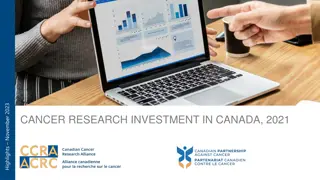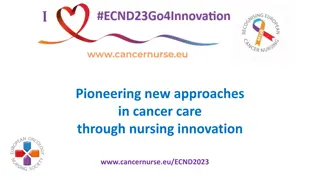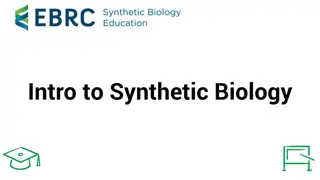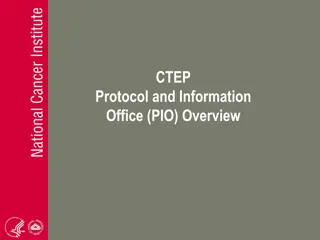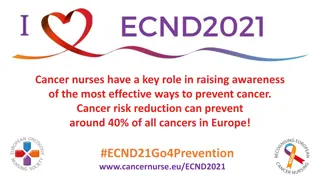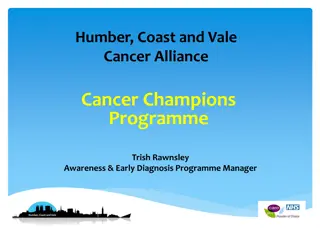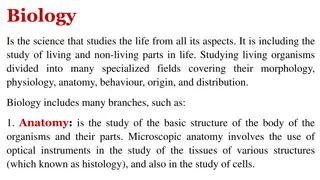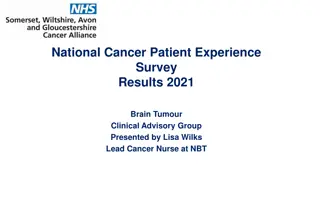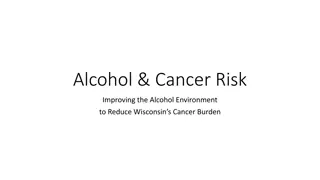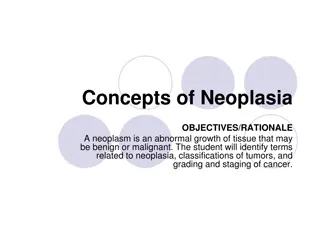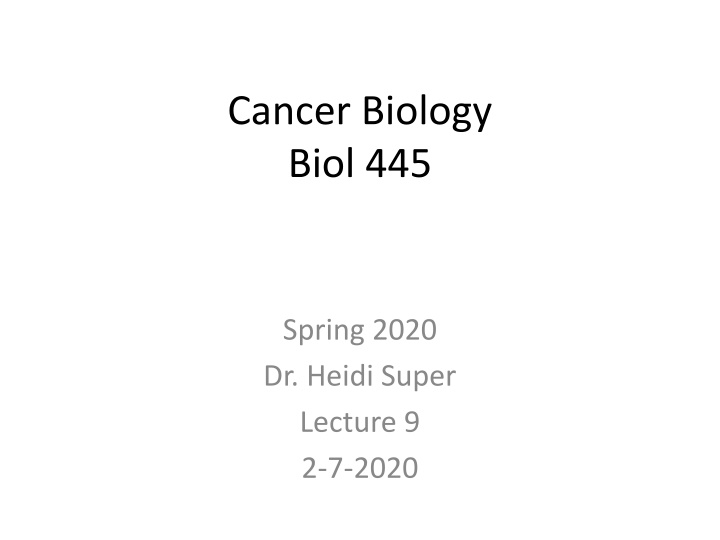
Understanding DNA Repair Mechanisms in Cancer Biology
Explore the critical role of DNA repair pathways in maintaining genomic integrity, the impact of repair mechanisms on mutation rates, and the significance of repair errors in somatic cells. Learn about key processes like mismatch repair, excision repair, and DNA break repair, and how they can influence genetic stability and disease progression in cancer biology.
Uploaded on | 1 Views
Download Presentation

Please find below an Image/Link to download the presentation.
The content on the website is provided AS IS for your information and personal use only. It may not be sold, licensed, or shared on other websites without obtaining consent from the author. If you encounter any issues during the download, it is possible that the publisher has removed the file from their server.
You are allowed to download the files provided on this website for personal or commercial use, subject to the condition that they are used lawfully. All files are the property of their respective owners.
The content on the website is provided AS IS for your information and personal use only. It may not be sold, licensed, or shared on other websites without obtaining consent from the author.
E N D
Presentation Transcript
Cancer Biology Biol 445 Spring 2020 Dr. Heidi Super Lecture 9 2-7-2020
Field trip! I have arranged to visit Dr. Badie Alakech a pathologist at Trinity Hospital. Let s choose a date---February 19th, 24thor 26th.
Where were we? Summarized result of different types of mutations. Began discussing how cells do not necessarily have to maintain mutations/damage, but can often repair (or prevent it) it before the next round of replication.
How? DNA polymerase repair activities Several DNA repair pathways 1. Excision repair a. Base excision b. Nucleotide excision 2. Mismatch Repair
Critical that mismatch repair enzymes detect the newly synthesized DNA strand Otherwise, mismatch repair would create as many mutations as it would fix! Mismatch repair occurs concurrently with DNA replication Components of mismatch repair recognize the new DNA strand, in part because it has not yet been modified in any way.
3. Repair of DNA breaks A. Homologous end joining the system of recombining sections of homologous chromosomes during meiosis can be employed to repair one chromosome, by using the other as template. B. Non-homologous end joining: A separate set of repair proteins can join ends of DNA without the requirement of having homologous sequence.
In somatic cells, DNA maintenance and repair is essential for the health of the cell. Interestingly, some of the repair mechanisms are themselves error prone and can result in introduction of mutations in the process of trying to repair.
For example Non-homologous end joining (NHEJ) is likely responsible for the bulk of chromosome translocations that occur in cells. In the attempt to bring together the ends of a chromosome with a double strand break, the broken ends of 2 non-homologous chromosomes are joined instead. (Such as is seen in the Philadelphia chromosome)
Weve added new possibilities for cancer-associated genes Thus far: Cell cycle promoters (proto-oncogenes) Tumor suppressors (cell cycle pauses) Genes associated with growth factor signal transduction Genes associated with apoptosis Telomerase And now genes associated with DNA replication, recombination and repair.
Just a few examples BRCA1 and BRCA2 mutations, which occur spontaneously or are inherited, increase a woman s chance of breast and ovarian cancer over her lifetime. ( more in chpt. 10 p. 187-188) The protein products of BRCA1 and BRCA2 are involved in repair of double strand DNA breaks. They are considered tumor suppressor genes---why? So what s the link to cancer? Explain!
More An inherited disease called Xeroderma pimentosum (XP is caused by mutations in genes associated with nucleotide excision repair. ( more in chpt. 10 p. 187-188) Individuals with XP, are especially susceptible to UV caused skin cancers. Why? Be specific.
More? Do a google search and read about the inherited colon cancer, HNPCC Which repair system is faulty? Also more in chpt. 10 p. 187-188 Explain it in molecular/genetic terms
Lets return to a cancer-associated gene that has a celebrity spokesperson.
BRCA1 and BRCA2 mutations, which occur spontaneously or are inherited, increase a woman s chance of breast and ovarian cancer over her lifetime. According to the NCI---
NCI According to estimates of lifetime risk, about 12.0 percent of women in the general population will develop breast cancer sometime during their lives compared with about 60 percent of women who have inherited a mutation in BRCA1 or BRCA2 (a 5X increased risk) or 5-fold relative risk.
It remains unknown why inherited mutations in BRCA1/2 would be associated with cancer of just/primarily the breast and ovary---After all, an inherited mutation will affect DNA repair in all cells What action did Angelina Jolie take when she learned of her BRCA mutations?
Interestinglybut maybe making more sense Recently, inheritd BRCA mutations have been noted in other types of cancer cells. BRCA MUTATIONS IN PROSTATE CANCER Estimates of the relative risk of PCa for men with BRCA1 and BRCA2 mutations have varied, but recent data suggest that it is 3.75-fold for BRCA1 mutations and 8.6-fold for BRCA2 by age 65 years. 9-11 Moreover, PCas associated with BRCA1/2 mutations, particularly those in the BRCA2 gene, are often more aggressive and characterized by poor outcomes.12,13 The presence of a BRCA2 mutation is a negative prognostic factor in PCa, independent of tumor grade, stage, and PSA levels.14
When several individuals in one family get breast or ovarian cancer especially at a young age, there is reason to suspect a BRCA1 and/or BRCA2 mutation is being passed through the family. Myriad Genetics is one biotech company that offers genetic testing for such mutations. (More on this soon see recent paper)
Just a note of caution Most cancers are NOT passed from one generation to another. Cancer has a genetic basis, but that does not mean we get the disease from our parents! Cancer is a disease of somatic cells. However, a handful of gene mutations put a person at higher risk for developing cancer. If they are in the germline, we pass cancer-associated alleles on to the next generation. Some of these alleles result in defects in DNA repair.
Before we leave this sectionIt sometimes gets confusing when we learn about the causes of cancer DNA damaging agents chemicals and radiation And the treatments for cancer chemicals and radiation! WHAT?
Common classes of Cancer Chemotherapy agents DNA analogs Alkylating agents Radiation Inhibitors of DNA repair
Why? Yikes?! Historically, the best way to kill cancer cells is to damage them beyond repair in an attempt to tip them into apoptosis. Surprisingly, these fairly non-selective agents are still the best (sometimes, only) treatments.
Consequences? Side effects non-specific killing of non-cancer, rapidly dividing cells. Hair loss, intestinal damage, immune suppression. Sometimes, secondary, therapy-induced cancer. i.e. secondary leukemia.
Chapter 3 Thus far our focus has been on the cancer cell and the mechanism by which a cell can lose control of division. Cancer cells and even tumors are relatively harmless in isolation. In fact, tumors are limited in their growth (to a few millimeters) since all cells/tissues need a source of oxygen and nutrients to exceed a certain size.
Cancer/tumor progression requires establishment of a vascular system---delivery of oxygen and nutrients via the blood. Establishment of new blood vessels= angiogenesis
Angiogenesis is rampant and necessary during embryogenesis in most animals, but not common in adults. Exceptions Wound healing Normal menstrual cycle Pregnancy
Blood vessels are made from endothelial cells First step in tumor angiogenesis is proliferation and of endothelial cells endothelial cells lining existing blood vessels. 3-1
It was once hypothesized that the growth of new blood vessels to feed tumors was the result of an immune response. Studies of solid tumors in their original location shows many similarities to a wound healing sight.
Several scientists, including Judah Folkman, made important discoveries that tumor cells secrete growth factors which activate nearby blood vessels to begin angiogenesis. Fig 3-2
Judah Folkman 1934-2008
Folkmans research identified a new class of growth factors associated specifically with angiogenesis.
Vascular Endothelial Growth Factor VEGF is among the most important of the angiogenic factors. Endothelial cells express VEGF receptors. Binding of VEGF starts a signal transduction cascade which induces the production and secretion of a new type of protein called matrix metalloproteinases (MMPs) by the endothelial cells.
Several other angiogenic factors Epidermal Growth Factor (EGF) Fibroblast Growth Factor (FGF) Granulocyte colony stimulating factor (GCSF) Interleukins Tumor Necrosis Factor alpha (TNF ) Platelet-derived endothelial growth factor (TGF )
Every growth activity must be tightly regulated Folkman (and others), also identified naturally occuring anti-angiogenic factors. Angiostatin Endostatin Interferons Thrombospondin
The discovery of anti-angiogenic compounds spurred much excitement and a major push for development of these as therapeutic agents.
Why so much hope?... The biggest challenge of therapeutic approaches at the time, was making sure every cancer cell was killed. (And tumor cells nearly always develop resistance to single treatments) The new approach did away with that requirement. Tumor cells could persist, but without a vascular system, could not grow to dangerous size.
Figure 3-6 Immunocompromised mice injected with tumor cells Plus endostatin. Conclusion ?
Avastin First FDA-approved anti-angiogenesis drug used in humans (2004) despite failing some phase III drug trials, including a trial for breast cancer. Has had very limited success .kidney and colorectal cancer.


